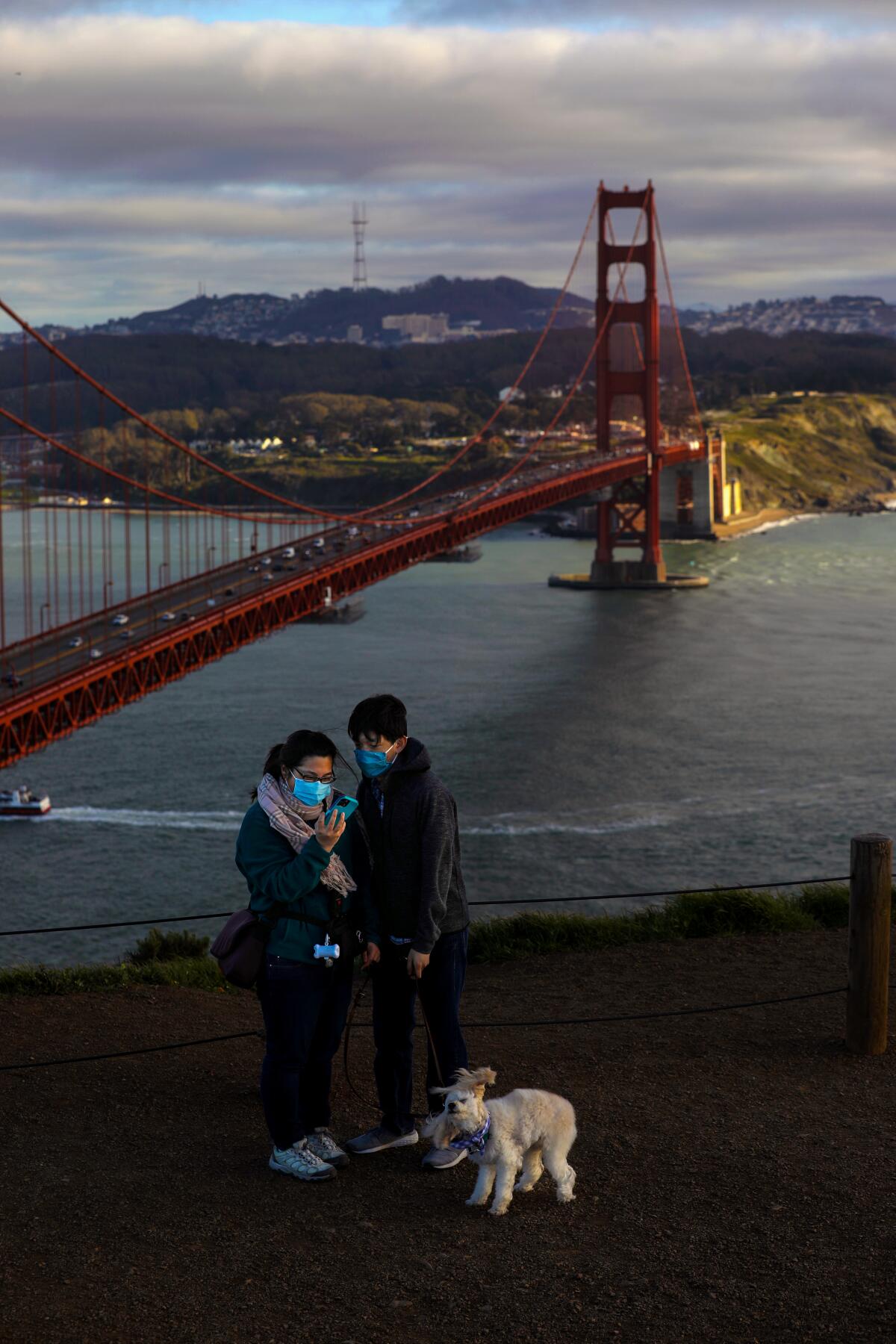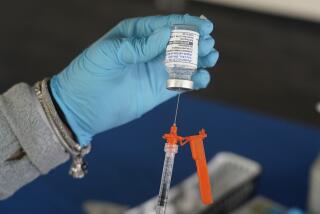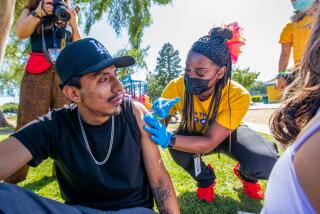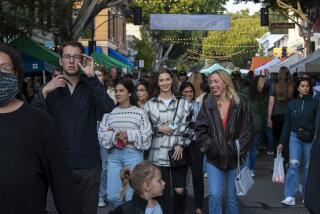San Francisco is nearing coronavirus herd immunity, but L.A. still has months to go

San Francisco is nearing herd immunity, some experts believe, a milestone in California’s efforts to gain control of the COVID-19 pandemic.
San Francisco has one of California’s highest rates of vaccination, with 72% of residents having received at least one dose. Only one other county in California — Marin, just north of San Francisco — has a higher rate of vaccination, with 75% of residents there at least partially vaccinated.
Both San Francisco and Marin County’s rates are significantly higher than the statewide vaccination rate of 56%.
Herd immunity, also known as community immunity, occurs when a significant percentage of the overall population is immune either through vaccination or from surviving a previous infection. People without immunity to a disease are indirectly protected by herd immunity.
There is no definitive percentage at which herd immunity to the coronavirus is achieved. It can be tested only when essentially all restrictions are loosened and officials observe whether disease transmission increases.
Previous guesses for the point at which herd immunity will be achieved have ranged from 70% to 85% of community members with immunity.
Despite the hazy parameters around reaching herd immunity, getting closer to it by maximizing vaccination rates remains a paramount goal of public health experts.
“I think San Francisco is pretty close,” said Dr. George Rutherford, a UC San Francisco epidemiologist who believes more than 75% of a population probably needs to be immune before herd immunity is achieved. “I think we’re in really good shape here, here meaning the city [of San Francisco]. Other places, we’re plenty close.”
San Diego, Santa Clara and San Mateo counties also have some of the state’s highest vaccination rates, with nearly 70% of their residents at least partially vaccinated.
Other counties in or near the Bay Area have similarly high rates. In Alameda County, which is home to Oakland, 67% of residents have had at least one dose of vaccine; in Napa County, it’s 66%; Contra Costa County, 65%; Santa Cruz County, 64%; and Sonoma County, 63%.
By contrast, in Orange and Ventura counties, 57% of residents are at least partially vaccinated; in Santa Barbara County, 56%; Los Angeles County, 55%; Sacramento County, 51%; Fresno County, 46%; Riverside County, 45%; San Bernardino County, 41%; and Kern County, 38%.
Statewide, about 15% of California residents are younger than 12; no vaccines are yet authorized for use among these young children.
L.A. County Public Health Director Barbara Ferrer said she did not believe the county had achieved herd immunity yet; she is hoping to reach that goal by the end of the summer.
“We have a lot of people not vaccinated still,” Ferrer said.
Nothing happens suddenly when herd immunity is achieved — daily coronavirus case rates are already extraordinarily low in San Francisco. And, technically, herd immunity is reached gradually: The more people who gain immunity, the slower the rate of disease transmission.
But once herd immunity is achieved, new coronavirus cases introduced among unvaccinated people, such as through travelers, are unlikely to spread beyond a small outbreak or to start growing exponentially throughout a community.
“You’re not going to see these prolonged chains of transmission,” Ferrer said, assuming unvaccinated people are randomly distributed in the population and aren’t all congregating together.
Some experts have expressed confidence that California will not backslide into a worse phase of the pandemic after Tuesday, when the state is set to fully reopen its economy and lift the vast majority of business restrictions aimed at curbing the spread of the coronavirus. For California counties in the state’s least-restrictive reopening tier, the rules have kept indoor restaurants and gyms at 50% of capacity.
“We will see on June 15 if we stay at low cases — I actually have no doubt that we will,” said Dr. Monica Gandhi, a UC San Francisco infectious-diseases specialist.
California is already recording extraordinarily low COVID-19 hospitalization rates — there are roughly 1,000 people with COVID-19 in hospitals in the state, down from about 22,000 in January. The latest numbers translate to a rate of about 2.6 Californians hospitalized with COVID-19 for every 100,000 residents, down from a peak of 56 per 100,000 residents.
The latest number is significant because Gandhi suggested in April that a good milestone for when restrictions such as masking and social distancing can ease is when hospitalization numbers fall below 5 for every 100,000 residents. During the peak of the flu season, hospitalization rates for the flu on average top out at about 20 to 40 per 100,000 residents.
Other countries with the world’s fastest per capita vaccine administrations show promising patterns. Israel recently ended rules that restricted unvaccinated people from entering certain venues, Gandhi said.
On Tuesday, federal officials expressed concern about the rise of the Delta variant, which was originally identified in India and spread in 60 countries, including the U.S. and the United Kingdom.
Dr. Anthony Fauci, the U.S. government’s top infectious-diseases expert, said the Delta variant was more transmissible than the Alpha variant, which originally was identified in the U.K. and since became dominant in the U.S.
“It may be associated with an increased disease severity,” he said, “such as hospitalization risk, compared to Alpha.”
But studies show that two doses of the Pfizer-BioNTech and AstraZeneca vaccines provide sufficient immunity to protect against infection by the Delta variant, Fauci said.
AstraZeneca’s COVID-19 vaccine is not authorized for use in the U.S. but is similar to the one manufactured by Johnson & Johnson, which is in use here.
More to Read
Sign up for Essential California
The most important California stories and recommendations in your inbox every morning.
You may occasionally receive promotional content from the Los Angeles Times.












